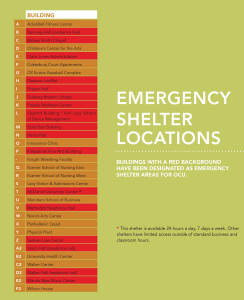Oklahoma’s current severe weather season will be slightly different than in the past.
Severe weather season usually starts around March and goes until the beginning of June, but it looks like this year tornado season will extend into mid to late June said Damon Lane, KOCO chief meteorologist. He said this severe weather season will likely start off quietly because of El Niño.
El Niño is the warm and cool phases of a recurring climate pattern across the tropical Pacific, according to the National Oceanic and Atmospheric Administration. The pattern can shift back and forth irregularly every two to seven years, and each phase triggers predictable disruptions of temperature, precipitation and winds.
“Just because we have a slow start to the storm season, which is what we’re expecting, doesn’t mean it’s always going to finish slow,” Lane said. “It looks like, going into May, we’ll probably have a pretty good chance at seven to nine tornado watches that will be issued across Oklahoma City.”
The peak of the season tends to be at the beginning of May, right in time for finals and graduation, said Lee Brown, university risk manager. He said to stay as aware as possible.
Monica Hiller, elementary education sophomore, said she used to go into the storm cellar as soon as her area was under tornado watch.
“Now that I’m older, I have turned into more of a stand on the cellar and watch it until it gets close person,” she said.
Brown advises against this. He said:
This year things are going to be a little different. If you hear a siren, not only will we issue a Blue Alert immediately, but you will have to get to the lowest point possible of the building you’re in.”
In the past, sirens have sounded all through the county when a tornado warning was issued anywhere in Oklahoma county.
“What made that a problem is that Oklahoma City actually extends into far eastern Oklahoma County and even in the eastern Cleveland County,” Lane said. “Now Oklahoma County is going to be divided into quadrants, and basically if you hear the sirens now sounding then it’s because you are in the path of the storm.”
The sirens sound for three minutes only when a tornado warning is issued in that specific area or when they are testing them. They do not sound during a tornado watch.
The National Weather Service issues a tornado watch when tornados are possible in your area. A tornado warning is issued when a tornado actually has been sighted or indicated by radar, according to Oklahoma City’s website.
Oklahoma City tests the sirens for three minutes at noon on Saturdays when there is no risk of severe weather.
Their website says to turn on a television or radio if the weather looks threatening, and warns people not to count on a siren to wake you or get your attention above the background noise of your home or car.
 “Shelter locations are listed in the Emergency Resource Guide, which is in every conference room and classroom on campus,” Brown said. “In addition to that, they’re going to be found on the OCU emergency main page. So know where your shelter locations are, and know how to get to them.”
“Shelter locations are listed in the Emergency Resource Guide, which is in every conference room and classroom on campus,” Brown said. “In addition to that, they’re going to be found on the OCU emergency main page. So know where your shelter locations are, and know how to get to them.”
There are 17 shelter locations on campus. The Tom and Brenda McDaniel University Center is available as a shelter 24 hours every day of the week.
If you are in the state and not on campus when a siren sounds, go to the lowest level of the building. Lane said you are safe even if you don’t have a basement, as long as you go into the innermost room of the building you are in.
Lane said:
We want everyone to know that you can survive a tornado above ground, as long as you’re away from windows and in the innermost room of the building.”
Karen Vasquez, nursing sophomore, said she knew people who lost family members during the 2013 tornado that destroyed parts of Moore, Okla.
“I was overwhelmed with thoughts of what had happened and how many people were affected,” she said. “All I could think about was losing my loved ones because of a storm. Ever since then, my family and I take tornado warnings serious and take precautions.
Lane said one of the most important things that anyone coming into Oklahoma can do is know when storms are going to be at their worst so they have enough time to prepare.
“We know that when storm season systems start coming in here in March, April, May, they’re going to get pretty bad and that helps people plan better,” he said. “It’s always best to have a plan days, weeks, months in advance rather than coming up with that plan when the warning sounds.”


Leave a Reply